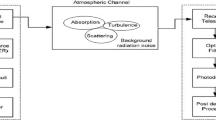Abstract
Free space optical (FSO) communication systems can be the only solution to transmit high-speed data in urban areas wireless networks. FSO communication systems are more suitable for 5G point to point communications. Performance of FSO communication systems is well-determined based on the type of modulation techniques employed as well as signal propagation under various atmospheric conditions. Proposed work is focused upon evaluating performance of FSO systems that employed OOK, BPSK, MPSK M-QAM modulation techniques in transmitters and antenna diodes (APD) in receivers. Analysis of proposed FSO communication system is carried out considering an atmospherically turbulent gamma channel model and normal (turbulence free) channel model in the case of weak/medium and strong air turbulence in air channels. The Bit Error Rate (BER) of the proposed FSO system is estimated based on various parameters like APD quantum noise, intensity of the turbulence, thermal noise of system, back ground loss, channel attenuation, link distance, etc.









Similar content being viewed by others
References:
Bach T. Vu, Ngoc T. Dang, Truong C. Thang, Anh T. Pham, Bit Error rate analysis of rectangular QAM/FSO systems using an APD receiver over atmospheric turbulence channels. J. Opt. Commu. Network. 5(5), 437–446 (2013)
R. Kaushik, V. Khandelwal, R.C. Jain, A new closed form approximation for BER for optical wireless systems in weak atmospheric turbulence. J. Opt. Commu. 39(2), 247–253 (2018)
Haixing Miao, Nicolas D. Smith, Matthew Evans, Quantum limit for laser interferometric gravitational-wave detectors from optical dissipation. Phys. Rev. X. 9(1), 011053 (2019)
R. Kaushik, V. Khandelwal, R.C. Jain, An approximation for ber of optical wireless system under weak atmospheric turbulence using point estimate. J. Opt. Commu. 40(4), 473–479 (2019)
Z. Rajbhandari, “FSO link performance under the effect of atmospheric turbulence optical wireless communications system and channel modelling with MATLAB® (CRC Press, Francis, 2012)
Antonio García-Zambrana, Carmen Castillo-Vázquez, Beatriz Castillo-Vázquez, Alejandro Hiniesta-Gómez, Selection transmit diversity for FSO links over strong atmospheric turbulence channels. IEEE Photon. Technol. Let. 21(14), 1017 (2009)
Zixiong Wang, Wen-De. Zhong, Yu. Changyuan, Performance improvement of OOK free-space optical communication systems by coherent detection and dynamic decision threshold in atmospheric turbulence conditions. IEEE Photon. Technol. Let. 24(22), 2035 (2012)
Bach T. Vu, Ngoc T. Dang, Truong C. Thang, Anh T. Pham, Bit error rate analysis of rectangular QAM/FSO systems using an APD receiver over atmospheric turbulence channels. J. Opt. Commun. Netw. 5(5), 437 (2013)
Kostas P. Peppas, P. Takis Mathiopoulos, Free-space optical communication with spatial modulation and coherent detection over h-k atmospheric turbulence channels. J. Lightwave Technol. 33(20), 4221–4232 (2015). https://doi.org/10.1109/JLT.2015.2465385
Abir Touati, Abderrazak Abdaoui, Farid Touati, Murat Uysal, Ammar Bouallegue, On the effects of combined atmospheric fading and misalignment on the hybrid FSO/RF transmission. J. Opt. Commun. Netw. 8(10), 710–715 (2016)
Mohammad Ali Amirabadi, Vahid Tabataba Vakili, A new optimization problem in FSO communication system. IEEE Commun. Lett. 22(7), 1442–1445 (2018). https://doi.org/10.1109/LCOMM.2018.2831710
Soyinka Nath, Sujata Sengar, Shreesh Kumar Shrivastava, and Shree Prakash Singh, “Impact of Atmospheric Turbulence, Pointing Error, and Traffic Pattern on the Performance of Cognitive Hybrid FSO/RF System.” IEEE Trans. Cognit. Commun. Network. 5(4), 1194 (2019)
Ajanta Barh, Peter Tidemand-Lichtenberg, Christian Pedersen, Thermal noise in mid-infrared broadband upconversion detectors. Opt. Express. 26(3), 3249 (2018)
Z. Xu, G. Xu, Z. Zheng, BER and channel capacity performance of an FSO communication system over atmospheric turbulence with different types of noise. Sensors 21, 3454 (2021). https://doi.org/10.3390/s21103454
R. KVÍČALA, V. KVIČERA, M. GRÁBNER, O. FIŠER. BER and availability measured on FSO Link. Radio Eng. 16(3), 17–22 (2007)
M. Venkatachalam, P. Loganathan, System stability improvement and cost-effective solution by accelerated distance protection using direct Fiber optic signal. J. Inst. Eng. (India) Ser. B 102(3), 531–537 (2021). https://doi.org/10.1007/s40031-021-00562-0
Sonali Chauhan, Rajan Miglani, Lavish Kansal, Gurjot Singh Gaba, Mehedi Masud, Performance analysis and enhancement of free space optical links for developing state-of-the-art smart city framework. Photonics 7(4), 132 (2020). https://doi.org/10.3390/photonics7040132
V. Srivastava, A. Mandloi, G.G. Soni, Outage probability and average BER estimation of FSO system employing wavelength diversity. Opt. Quant. Electron. 51, 229 (2019). https://doi.org/10.1007/s11082-019-1943-4
H. Singh, N. Mittal, H. Singh, Analysis of Bit error rate performance and atmospheric attenuation coefficient of free space optical (FSO) link. Int. J. Adv. Sci. Technol. 29(10s), 1635–1642 (2020)
S.S. Abdelhak, A.E. Morra, F.E. Abd El-Samie, A.E. Elfiqi, Performance analysis of different intensity modulation techniques over atmospheric turbulent free-space optical channels. J Opt Soc Am A Opt Image Sci Vis. 37(11), C138–C145 (2020)
Shantanu Jagdale, Brijesh Iyer, Sanjay L. Nalbalwar, Shankar B. Deosarkar, Design of high speed multistream free space optics link under clear weather condition. Int. J. Auton. Comput. (IJAC). 3(3/4), 195 (2020)
V.P. Singh, S. Gupta, H. Pasupuleti et al., A methodology to study the effect of smoke and fire on indoor RF propagation. J. Inst. Eng. India Ser. B. 100, 33–39 (2019)
Acknowledgments
The authors would like to acknowledge Lendi Institute of Engineering and Technology, Jonnada, Vizianagaram, India for their support of the research work.
Funding
The author(s) received no financial support for the authorship, and/or publication of this article.
Author information
Authors and Affiliations
Corresponding author
Ethics declarations
Conflict of interest
The authors declare there is no conflict of interest.
Additional information
Publisher's Note
Springer Nature remains neutral with regard to jurisdictional claims in published maps and institutional affiliations.
Rights and permissions
Springer Nature or its licensor holds exclusive rights to this article under a publishing agreement with the author(s) or other rightsholder(s); author self-archiving of the accepted manuscript version of this article is solely governed by the terms of such publishing agreement and applicable law.
About this article
Cite this article
Sridhar, B., Sridhar, S. & Nanchariah, V. Performance Evaluation of FSO System under Atmospheric Turbulence and Noise. J. Inst. Eng. India Ser. B 103, 2085–2095 (2022). https://doi.org/10.1007/s40031-022-00789-5
Received:
Accepted:
Published:
Issue Date:
DOI: https://doi.org/10.1007/s40031-022-00789-5




